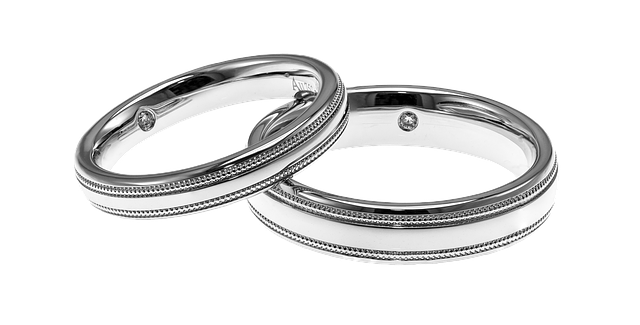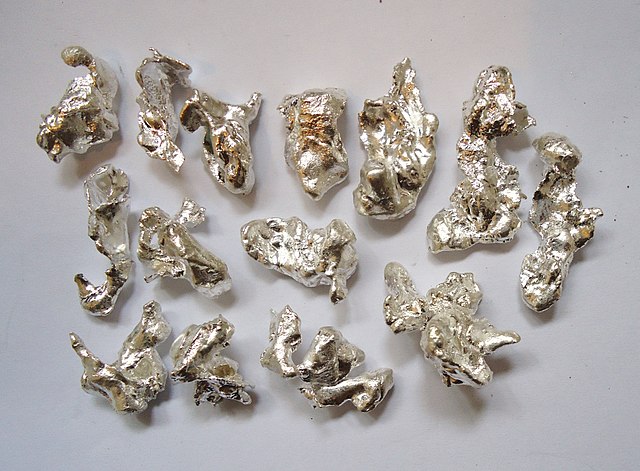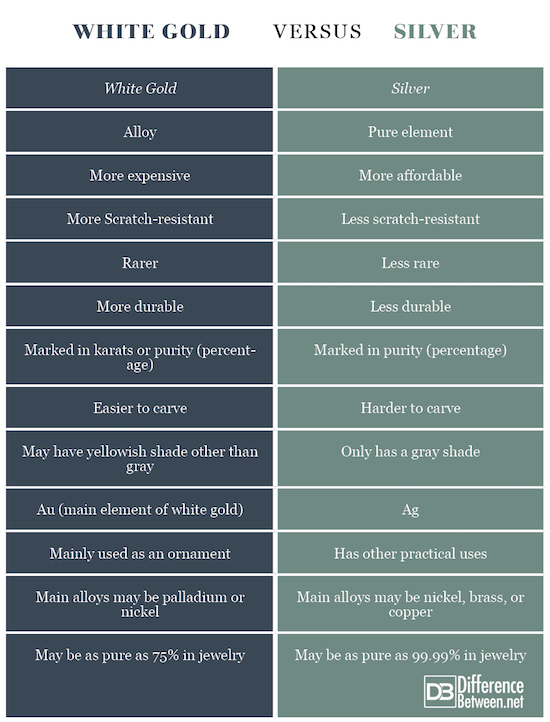Difference Between White Gold and Silver
White gold and silver may look very similar and are often used making precious jewelry such as necklaces and wedding bands. Both of these need to be polished regularly to prevent tarnishing. For most people, it is difficult to tell which one is which with the naked eye. White gold is usually coated with rhodium, manganese, palladium, or nickel which is a kind of white metal that enhances strength and luminescence. As for silver, it is often combined with copper to give off that similar sparkling white look.
What is White Gold?
Gold came from the Latin word “aurum” and white gold is an alloy (combination of metals) which shines like a mirror due to its white metal plating. The usual combination is 90% gold and 10% nickel. In the jewel industry, it is often loosely referring to any gold alloy with a whitish hue. Thus, it covers a range of colors from pale rose to pale yellow. Rhodium plating is also usually used to give off that silvery glow shown in advertisements.
Gold jewelry is marked with karats or gold purity. For instance, 18k is 75% pure and 14k is 58% pure. The following table features the most common mixes in producing white gold:
| PERCENTAGE OF: | |||||||
| Type | Gold | Nickel | Copper | Zinc | Silver | Palladium | |
| 14k White gold with Nickel | 58.3 | 11 | 23 | 7.7 | |||
| 18k White gold with Nickel | 75 | 8 | 10 | 4.5 | 2.5 | ||
| 14kt White Gold with Palladium | 58.33 | 32.17 | 9.5 | ||||
| 18 kt White Gold with Palladium | 75 | 25 | |||||
What is Silver?
Silver came from the Latin term “argentum” which means “white” or “shiny”. It is a pure chemical element and has the highest reflectivity as well as thermal and electrical conductivity as compared to any pure metal. Native silver, which is the pure elemental form and found in the earth’s crust, occurs at 0.08 parts per million. Silver is most often formed as a byproduct of refining gold, zinc, lead, and copper.
Regarding its marking, the purity of silver is specified. For instance, a “925” indication is present in sterling silver jewelry. The following table shows the most common mixtures:
| PERCENTAGE OF: | |||||||
| Type | Silver | Trace Elements | Nickel | Copper | Germanium | Brass | |
| Fine Silver | 99.99 | 0.01 | |||||
| Sterling Silver | 92.5 | 7.5 (if not Copper) | 7.5 (if not Nickel) | ||||
| Argentium and Non-tarnish Alloy | 92.5 | 5.5 (may vary) | 2 (may vary) | ||||
| Coin Silver | 90 | 10 | |||||
| Silver-Filled | 5-10 | 90-95 | |||||
Difference between White Gold and Silver
-
Purity of White Gold and Silver
White gold is an alloy since it is formed by combining pure gold with a white metal. On the other hand, silver is a pure element.
-
Cost of White Gold and Silver
As white gold is rarer and durable, it is likewise more expensive than silver.
-
Scratch-Resistant in White Gold and Silver
White gold is more scratch-resistant as compared to silver.
-
Corrosion
As compared to silver, white gold corrodes less easily.
-
Plating
White gold is often plated with rhodium for its mirror-like look while silver does not need such plating for its gray luster.
-
Carving
It is usually easier to carve on white gold as it is more malleable than silver.
-
Markings
White gold is marked in karats or purity percentage while silver is marked in purity percentage only.
-
Shades
As silver is purer, it only has a gray shade. On the other hand, white gold can have a yellowish shade as well as a grayish one which largely depends on its plating.
-
Symbol
The symbol of silver, is “Ag”, from the Latin word “argentum” which means “shiny” or “white” whereas the symbol for the main component of white gold is “Au” from the Latin word “aurum” which literally means “gold”.
-
Alloys
Copper or Nickel is usually added to silver while rhodium, nickel, or palladium is usually mixed with gold.
-
Abundance
As compared to gold, silver is more naturally abundant. White gold is more expensive as it is harder to produce.
-
Non-ornamental Use
Aside from ornamental purposes, silver is also used in medicine, confectionary, and engineering. On the contrary, white gold is solely used in jewelry or other ornamental pieces.
-
Types
White gold is classified according to the karats of pure gold used, whether it is 14k or 18k, and its main alloy, whether nickel or palladium. There are usually four classifications. As for silver, it is classified to the percentage of silver (99.99%, 92.5%, or 5-10%) and its alloys (copper, germanium, nickel, brass).
-
Purity of Main Metal in Jewelry
Silver jewelry can be as pure as 99.99% while white gold ones can only be as pure as 75%.
White Gold vs Silver: Comparison Chart
Summary of White Gold and Silver
- Both white gold and silver give off that mirror-like shine and are highly used in the jewelry industry.
- White gold is an alloy while silver is a pure element.
- As compared to silver, white gold is more expensive since it is more durable and rarer.
- White gold may be marked in karats while silver is only marked in purity percentage.
- It is easier to carve on gold as it is more malleable.
- Silver has a shade of gray while white gold may also have a yellowish hue.
- While white gold is mainly utilized as an ornament, silver may also have other practical uses.
- The main alloys used for white gold are palladium and nickel while that of silver are copper, nickel, and brass.
- In jewelry, the silver content can be as high as 99.99%. However, white gold’s content can only be as high as 75%.
- Difference Between Hematoma and Melanoma - February 9, 2023
- Difference Between Bruising and Necrosis - February 8, 2023
- Difference Between Brain Hematoma and Brain Hemorrhage - February 8, 2023
Search DifferenceBetween.net :
Leave a Response
References :
[0]Binnion, James. Jewelry Metals. Massachusetts: Manufacturing Jewelers and Suppliers of America, 2015. Print.
[1]McGrath, Jinks. The Complete Jewelry Making Course. Hongkong: Barrons, 2007. Print.
[2]Muttit, Louise Mary. Making Silver Jewelry. Ramsbury: The Crowood Press, 2014. Print.
[3]Image credit: https://pixabay.com/en/wedding-rings-white-gold-rings-1510162/
[4]Image credit: https://upload.wikimedia.org/wikipedia/commons/thumb/9/96/Fine_%28or_pure%29_silver.JPG/640px-Fine_%28or_pure%29_silver.JPG



